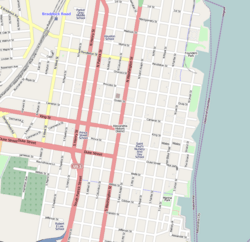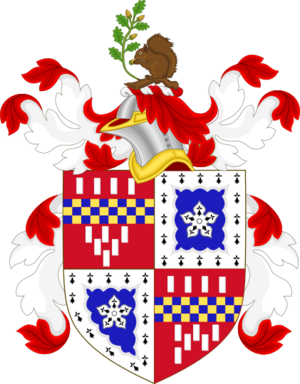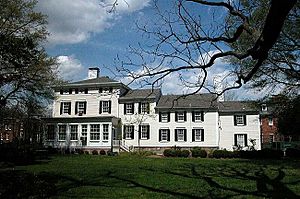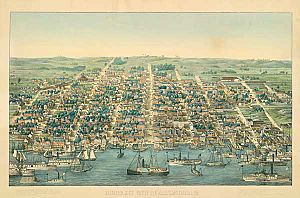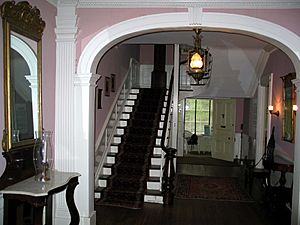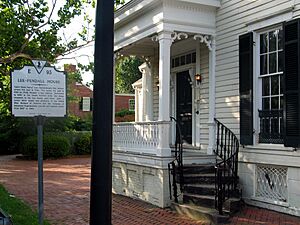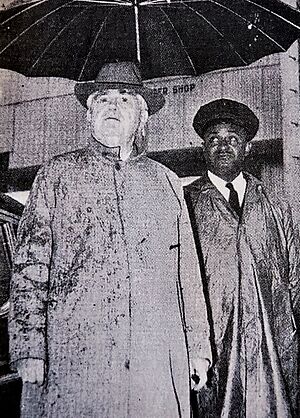Lee–Fendall House facts for kids
|
Lee–Fendall House
|
|
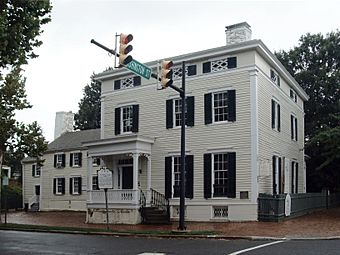
The Lee–Fendall House, seen in September 2009
|
|
| Location | 614 Oronoco Street, Alexandria, Virginia |
|---|---|
| Area | 0.5 acres (0.20 ha) |
| Built | 1785 |
| Architectural style | Greek Revival |
| NRHP reference No. | 79003277 |
Quick facts for kids Significant dates |
|
| Added to NRHP | June 22, 1979 |
The Lee–Fendall House is a historic house museum and garden located in Old Town Alexandria, Virginia. It stands at 614 Oronoco Street. Built in 1785, this house has a long and interesting history. It was home to many members of the famous Lee family for over a century. During the American Civil War, it even served as a hospital for Union soldiers. Later, it was home to the Downham family and then to the family of a powerful labor leader, John L. Lewis. Enslaved and free servants also lived and worked here over the years.
The house was built in 1785 on its original half-acre lot. Its design is called "telescopic style," which means it has sections that look like they're getting smaller, like a telescope. This style was common in Maryland but rare in northern Virginia. In 1850, the house was updated. It got new features in the Greek Revival and Italianate styles, making it look even grander.
This historic home is recognized as important by both the state and national governments. It is listed on the National Register of Historic Places and the Virginia Landmarks Register. It is also a key part of the National Historic Landmark District of Alexandria, Virginia. Today, the Virginia Trust for Historic Preservation owns and runs the house. It is known as the Lee–Fendall House Museum and Garden, offering exhibits, tours, and special events for visitors.
Home of the Lees
Building the House
In November 1784, Henry "Light Horse Harry" Lee III, a former military leader and later a senator and governor, bought three lots in Alexandria. On December 4, 1784, he sold one of these lots to his father-in-law, Philip Richard Fendall I. Fendall began building the Lee–Fendall House in the spring or early summer of 1785. He used enslaved laborers for the construction. The house was built for his second wife, Elizabeth (Steptoe) Lee.
The house was located on the edge of Alexandria at the time. The Fendalls had clear views of Oronoco Bay and the ships there. The architect of the house is not known. However, its "telescopic" design was similar to homes found in Maryland. The property also included other buildings, like an office and a dwelling for enslaved workers.
The house was finished by November 1785. George Washington himself visited and dined there many times. Elizabeth Fendall was a favorite of George and Martha Washington, often visiting Mount Vernon and hosting the Washingtons at her home. Philip Fendall was also a close friend of Washington.
After the American Revolution, Alexandria became known as the "Home Town of the Lees." The Lee–Fendall House is at "Lee Corner," a special intersection where many Lee family homes were located. Other Lee family members, like William Lee's daughter and Light Horse Harry Lee himself, lived in nearby houses. The Lee–Fendall House is the only one of these Lee family homes that is now a museum.
The Fendall and Henry Lee III Families
The Fendalls had lived at Stratford Hall before moving to Alexandria. Henry Lee III, Elizabeth Fendall's son-in-law, often visited the Fendall home in Alexandria. George Washington's diary shows he met Colonel Lee at the Fendall house. Henry Lee III was a famous cavalry leader during the Revolutionary War.
In 1789, Henry Lee III was asked to write a farewell speech for George Washington as he left Virginia to become the first President. A decade later, after Washington died in 1799, Lee wrote a famous eulogy for him. In this speech, he described Washington as "first in war, first in peace, and first in the hearts of his countrymen." After Washington's death, citizens met at the Lee–Fendall House to plan Alexandria's part in his funeral.
Philip Fendall was a successful businessman after the Revolutionary War. He was the first President of the Bank of Alexandria. However, like many others, he faced financial difficulties. Because of these problems, the house was transferred to Richard Bland Lee, Henry Lee III's younger brother, in 1792.
Elizabeth Fendall lived in the house until her death in 1789. In 1791, Philip Fendall married Henry Lee III's sister, Mary "Mollie" Lee. Mollie continued to live in the house with her children after Philip died in 1805.
In 1811, Henry Lee III rented a house across the street at 607 Oronoco. His son, Robert Edward Lee, who later became a famous general, often visited his Aunt Fendall's home across the street. Henry Lee III faced many challenges, including financial troubles and injuries. He died in 1818 while trying to return home to his family.
Records show that the Fendalls owned enslaved people. In 1785, they owned 51 enslaved people. By 1820, Mollie Fendall owned seven enslaved people. Some of these enslaved individuals may have lived in the back part of the house.
Edmund Jennings and Sally (Lee) Lee Family
After Mollie Fendall's death in 1827, her youngest brother, Edmund Jennings Lee I, bought the house. Edmund was also a brother of Henry Lee III. His wife, Sally Lee, was the youngest daughter of Richard Henry Lee, who signed the Declaration of Independence.
Edmund J. Lee was a lawyer, councilman, and mayor of Alexandria. He was active in many community groups. Like his brother Harry, Edmund also faced financial difficulties. He had to sell the house at auction in 1833. However, his son, Edmund Jennings Lee II, was able to buy it back in 1836. Edmund Sr. then moved into the Lee–Fendall House and lived there until his death in 1843.
In 1841, former President John Quincy Adams visited Alexandria and stayed at the Lee–Fendall House. Edmund Sr. hosted a party in his honor.
After Edmund J. Lee's death in 1843, his daughters, Hannah and Sally, inherited the house. They leased it to Lucy Lyons Turner, a family friend.
The Cazenove Family and House Renovation
In 1850, Louis Anthony Cazenove, a successful merchant, bought the Lee family home for his new wife, Harriotte Stuart. Harriotte was a great-granddaughter of Richard Henry Lee. Louis's daughters from his first marriage and his father also lived in the house.
The Cazenoves updated the home with the newest styles and technologies. They added Greek Revival and Italianate decorations to the original 1785 building. They also added front and back porches and a third floor to the main part of the house. They installed the first heating, plumbing, and servant bell systems. They also transformed the work yard into a beautiful Victorian garden. They planted trees, shrubs, and flowers, including the Magnolia, Black Walnut, and Gingko trees you can still see today.
When Louis and his father died in 1852, Harriotte was left to care for the house and children. In 1856, Harriotte moved her family to a new country home called "Stuartland." This new house was also in a similar "telescoping" style to the Lee–Fendall House.
When the American Civil War began, Harriotte Cazenove fled with her son. Union forces occupied Seminary Hill, and Stuartland likely became a headquarters. Harriotte leased the Lee–Fendall House until the war started. From 1861 to 1863, she rented the house to a New York railroad contractor and his family.
Malvina Harris
Malvina Harris was a child nurse and a freedwoman who worked for the Cazenoves. She was listed in the 1850 census as a mixed-race woman, 30 years old, who could not read or write.
American Civil War Union Army Hospital
In 1863, the Union Army took over the Lee–Fendall House. Edwin Bentley, the Chief Surgeon of Military Hospitals in Alexandria, requested the house for use as a medical building. The Union Army seized the house because Harriotte Cazenove refused to swear loyalty to the Federal Government. The house became an annex of the Grosvenor Hospital. Chief Surgeon Bentley likely moved his office there. It was here that he performed the first successful blood transfusion. Hundreds of soldiers recovered from injuries and illnesses at the house. Those who did not survive were placed in a morgue built at the back of the property.
Robert and Mary Elizabeth (Lee) Fleming Family
Harriotte Cazenove never got the house back after the war. In 1870, Dr. Robert Fleming bought it from the estate of Edmund Jennings Lee. Dr. Fleming had married Mary Elizabeth Lee, the eldest child of Colonel Richard Bland Lee II. Dr. Fleming died in 1871. Mary Fleming later moved to Washington, D.C., and allowed her three sisters and one brother to live in the house.
In 1879, Mary Fleming described the house as having "large grounds with fine trees and shrubbery."
After the Lees
Robert F. and Mai (Greenwell) Downham Family
After Mary Fleming's death in 1902, the house was to be sold. However, Myra Lee Civalier II, a relative who loved the house, was very upset. Her mother asked Myra's best friend, Mai R. Greenwell, to buy the house. Mai Greenwell was a singer and voice teacher. A suitor at the meeting, Robert Forsythe Downham, offered to buy the house for Mai if she would marry him. He bought the house for $5,500, ending the Lee family's long ownership. Between 1785 and 1903, 37 members of the Lee family had lived in the house.
Robert Downham, an Alexandria merchant, lived at Lee–Fendall with his family for 31 years. He was involved in many community organizations, including the Friendship Fire Association. He also helped raise money for the George Washington Masonic National Memorial. The museum has many photos of the Downham family enjoying the garden. In 1914, the Downhams hosted President Woodrow Wilson for a reception at the house.
Myrta and John L. Lewis Family
In 1937, the Downhams sold the house to Myrta Lewis, wife of John L. Lewis. John L. Lewis was the powerful president of the United Mine Workers union. The house was put in Myrta's name, likely to protect it from any legal issues her husband might face. For the next 32 years, the house was home to the Lewis family.
Myrta Edith (Bell) Lewis was a former schoolteacher and an antiques collector. She made many changes to the house, including painting the outside white. She died in 1942. Their daughter, Katherine, died in 1962, leaving John L. Lewis as the only family member living in the house.
John Llewellyn Lewis started as a coal miner in Iowa. He quickly rose through the union ranks to become president of the United Mine Workers of America (UMWA) for over 40 years. He moved the UMWA headquarters to Washington, DC to be closer to important leaders. As president, he greatly increased miners' wages and started the first safety rules in mines. He also helped create health care facilities where there were none before. He was one of the founders of the AFL–CIO, a large group of labor unions.
John L. Lewis was a strong leader. He challenged two presidents, Franklin Delano Roosevelt and Harry S. Truman. He led strikes that caused energy shortages, even during World War II. In 1945, he secured a welfare fund for miners, paid for by coal companies. He retired as President of the UMWA in 1960.
In 1964, President Lyndon B. Johnson gave Lewis the Presidential Medal of Freedom. John L. Lewis often walked in the garden in the years before his death. He died in the house on June 11, 1969, at the age of 89.
James Lewis, Jr.
In 1941, James Lewis, Jr. (who was not related to the Lewis family) began working for them. He was a chauffeur, special assistant, and house manager. He drove John L. Lewis around the country and managed the household until 1969. He was a trusted friend of the family and continued to work as a special assistant for six more UMWA presidents after John L. Lewis.
Virginia Trust for Historic Preservation
After John L. Lewis died, his son leased out the Lee–Fendall House until 1973. Then, he sold it to the Virginia Trust for Historic Preservation. This non-profit group was created in 1968 with the goal of buying and saving the house. The Trust received financial help from the Commonwealth of Virginia and the City of Alexandria to buy the property.
The Lee–Fendall House Museum and Garden opened to the public in 1974, just before the Nation's Bicentennial. This was a time when many people were interested in historic house museums. The first director of the Museum, Frances Shively, lived in the house without taking a salary to help save money. The museum relies on memberships, donations, grants, and money from tours and events. In 2015, a descendant of the Fendall family left money to the Trust to help with the museum's costs.
The museum's focus has grown over time. It now tells stories not only about the Lee family but also about enslaved people in Alexandria, life during the Union occupation, and social changes after the Civil War and in the early 1900s.
Between 1974 and 1976, over 500 women from Alexandria Garden Clubs helped restore the garden. First Lady Betty Ford personally helped raise money for the restoration. The garden was named Alexandria's official Bi-centennial Garden. From 2010 to 2011, archaeologists studied the garden and found more information about how it was used over the years.
Since it opened, the Lee–Fendall House has become a well-known Virginia landmark. It was added to the National Register of Historic Places and the Virginia Landmarks Register in 1979.
Today, the Lee–Fendall House Museum and Garden is an educational historic house museum. It also hosts special events and can be rented for private gatherings.
Images for kids


